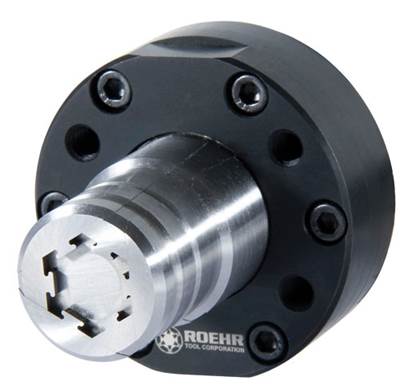Molding Very Small Threads and Undercuts Cleanly and Efficiently
New mold component technology helps engineers look differently at how they design small detailed parts.
When it comes to molding very small threaded plastic parts, including those with undercuts or straight walls, size does matter—but not as much as it used to.
Traditionally, the threads would be unscrewed or the holes would be tapped in a post-molding operation.
Similarly, undercuts in round molded parts would either be machined in as a secondary operation or stripped off of a solid core in the mold on ejection. Machining as a secondary operation is costly, however, and stripping off a solid core distorts the undercut geometry, resulting in inconsistency and inadequate snap retention forces.
Straight-wall parts are often crushed or distorted on ejection, and with very small parts, such as those smaller than 10 mm in diameter, these complications are amplified.
Fortunately, collapsible cores smaller than 10 mm in diameter provide an option for molding very small parts both cleanly and efficiently.
The first spring-type collapsible cores were developed more than 45 years ago, and since then, they have been used throughout the world to release undercut features such as threads, snap fits, O-ring grooves and side-wall through-holes. It wasn’t until 2009, however, that the standard dovetail-designed mechanical collapsing core was developed, making it possible to mold parts as small as 10 mm with a full 360-degree undercut. Dovetail collapsing-core technology brought with it additional benefits as well, including a shorter overall height; a stronger, more robust design; easier operation; and the ability to release deeper undercuts based on molded-part diameter.
Pushing Limits
Manufacturing the center pin and collapsing segments of dovetail cores smaller than 10 mm requires a very thin wire measuring 0.004 inch in diameter. Although wire EDM technology allows for the use of such a wire, the thickness of steel that can be cut is very limited. The challenge was determining how to cut steel as thick as 125 mm with these small-diameter wires to achieve sub-10mm molding capabilities.
After much R&D, a method was developed that pushed the limits of wire EDM technology even further, offering newer, more accurate controllers; accommodating wire sizes down to that magical 0.004-inch in diameter; and provides the ability to cut 125-mm-thick steel, so that collapsing solutions for molded parts as small as 7 mm in diameter are now possible.
With ongoing technological improvements, using wire sizes down to 0.001 appears to be a very real future capability. With more research and experimentation in cutting thicker steel with smaller-diameter wires, who knows how much smaller collapsible cores will be able to go?
A Viable Solution
Manufacturers of very small, complex medical devices and electrical connectors, in particular, have been requesting this capability for some time, and they are now able to realize the following cost-saving advantages:
• Elimination of secondary machining operations to achieve an adequate undercut form.
• Elimination of other secondary operations such as ultrasonic welding or gluing of two parts together.
• Simplification of multiple-piece assemblies into single components.
Collapsible cores also allow for a deeper, more robust snap feature that is consistent from shot to shot, because the collapse allows the undercut to be molded to full depth and released without distortion on ejection. In addition, the lead-in taper can be gentler and longer, because it does not have to drag on the undercut portion of the part during ejection. This enables two mating parts to be easily assembled while at the same time offering a snap fit that requires a much greater pull force for disassembly than would be attained by a stripped-off version of the same snap. The undercut can be 90 degrees to the diameter and have sharp corners instead of the rounded corners and angles necessary for the stripped version. The resultant tensile force that would be required to separate the two parts would lead to product destruction, but this ability of the two parts to separate is often desired or even required, such as with tamper-evident bands on screw-on bottle caps. In this case, collapsible cores provide a great solution when the final product requires easy assembly but hard disassembly.
Collapsible cores for threaded parts offer other advantages as well, including faster cycle times, a less-complex and less-expensive mold, and easier startup and maintenance. Collapsible cores also eliminate the need for internal draft for part ejection. Because the entire 360 degrees of the core is collapsing, the internal walls can be perfectly straight, making fit to mating parts more precise.
For all these reasons, a sub-10 mm, dovetail-style collapsible core is another useful tool in a part or mold designer’s toolbox. Innovations like this open up more windows of opportunity for molding very small, detailed parts.
Related Content
Solving Mold Alignment Problems with the Right Alignment Lock
Correct alignment lock selection can reduce maintenance costs and molding downtime, as well as increase part quality over the mold’s entire life.
Read MoreTreatment and Disposal of Used Metalworking Fluids
With greater emphasis on fluid longevity and fluid recycling, it is important to remember that water-based metalworking fluids are “consumable” and have a finite life.
Read MoreMoldmakers Deserve a Total Production Solution
Stability, spindle speed and software are essential consideration for your moldmaking machine tool.
Read MoreMachining Center Spindles: What You Need to Know
Why and how to research spindle technology before purchasing a machining center.
Read MoreRead Next
Advanced Prototyping for Threaded Parts
A look at a modular tooling standard designed to help cost effectively develop caps and closures to be either stripped out of the mold or use a collapsible core.
Read MoreHow to Use Strategic Planning Tools, Data to Manage the Human Side of Business
Q&A with Marion Wells, MMT EAB member and founder of Human Asset Management.
Read MoreHow to Use Continuing Education to Remain Competitive in Moldmaking
Continued training helps moldmakers make tooling decisions and properly use the latest cutting tool to efficiently machine high-quality molds.
Read More




















